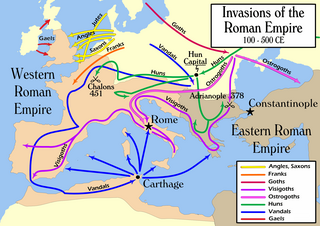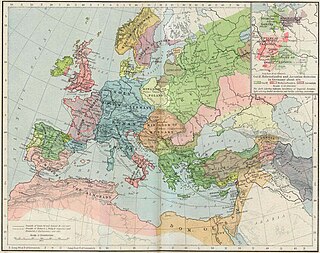
Medieval warfare is the warfare of the Middle Ages. Technological, cultural, and social advancements had forced a severe transformation in the character of warfare from antiquity, changing military tactics and the role of cavalry and artillery. In terms of fortification, the Middle Ages saw the emergence of the castle in Europe, which then spread to the Holy Land.

The 10th century was the period from 901 through 1000 (M) in accordance with the Julian calendar, and the last century of the 1st millennium.

The first millennium of the anno Domini or Common Era was a millennium spanning the years 1 to 1000. The world population rose more slowly than during the preceding millennium, from about 200 million in the year 1 to about 300 million in the year 1000.

The Migration Period, also known as the Barbarian Invasions, was a period in European history marked by large-scale migrations that saw the fall of the Western Roman Empire and subsequent settlement of its former territories by various tribes, and the establishment of the post-Roman kingdoms.

The Dark Ages is a term for the Early Middle Ages, or occasionally the entire Middle Ages, in Western Europe after the fall of the Western Roman Empire, which characterises it as marked by economic, intellectual, and cultural decline.

Historical reenactments is an educational or entertainment activity in which mainly amateur hobbyists and history enthusiasts dress in historic uniforms and follow a plan to recreate aspects of a historical event or period. This may be as narrow as a specific moment from a battle, such as the reenactment of Pickett's Charge presented during the 1913 Gettysburg reunion, or as broad as an entire period, such as Regency reenactment.
The spatha was a type of straight and long sword, measuring between 0.5 and 1 m, with a handle length of between 18 and 20 cm, in use in the territory of the Roman Empire during the 1st to 6th centuries AD. Later swords, from the 7th to 10th centuries, like the Viking swords, are recognizable derivatives and sometimes subsumed under the term spatha.

The High Middle Ages, or high medieval period, was the period of European history that lasted from AD 1000 to 1300. The High Middle Ages were preceded by the Early Middle Ages and were followed by the Late Middle Ages, which ended around AD 1500.

The Early Middle Ages, sometimes controversially referred to as the Dark Ages, is typically regarded by historians as lasting from the late 5th to the 10th century. They marked the start of the Middle Ages of European history, following the decline of the Western Roman Empire, and preceding the High Middle Ages. The alternative term late antiquity, for the early part of the period, emphasizes elements of continuity with the Roman Empire, while early Middle Ages is used to emphasize developments characteristic of the earlier medieval period.
Medieval archaeology is the study of humankind through its material culture, specialising in the period of the European Middle Ages. At its broadest, the period stretches from the 5th to the 16th century and refers to post-Roman but pre-modern remains. The period covers the upheaval caused by the Fall of the Western Roman Empire and cultures such as the Vikings, the Saxons, and the Franks. Archaeologists often specialise in studying either the Early Middle Ages or the High Middle Ages and Late Middle Ages, although many projects and professionals move across these chronological boundaries. The rich nature of the medieval written record means that archaeology has often been seen as the "handmaiden to history", especially in the Late Middle Ages. Analysis of material culture may enrich or call into question written evidence from the medieval period and the two sources of evidence need to be used together. Medieval archaeology has examined the development of medieval settlements, particularly the development of medieval towns, monasteries, and castles. It has also contributed to understanding of the spread and development of Christian monasticism during the medieval period.

Sub-Roman Britain is the period of late antiquity in Great Britain between the end of Roman rule and the Anglo-Saxon settlement. The term was originally used to describe archaeological remains found in 5th- and 6th-century AD sites that hinted at the decay of locally made wares from a previous higher standard under the Roman Empire. It is now used to describe the period that commenced with the recall of Roman troops to Gaul by Constantine III in 407 and to have concluded with the Battle of Deorham in 577.

Medieval reenactment is a form of historical reenactment that focuses on re-enacting European history in the period from the fall of Rome to about the end of the 15th century. The second half of this period is often called the Middle Ages. This multiplicity of terms is compounded by the variety of other terms used for the period.

Medieval theatre encompasses theatrical in the period between the fall of the Western Roman Empire in the 5th century and the beginning of the Renaissance in approximately the 15th century. The category of "medieval theatre" is vast, covering dramatic performance in Europe over a thousand-year period. A broad spectrum of genres needs to be considered, including mystery plays, morality plays, farces and masques. The themes were almost always religious. The most famous examples are the English cycle dramas, the York Mystery Plays, the Chester Mystery Plays, the Wakefield Mystery Plays, and the N-Town Plays, as well as the morality play known as Everyman. One of the first surviving secular plays in English is The Interlude of the Student and the Girl.
The following outline is provided as an overview of and topical guide to the Middle Ages:
Historical re-enactment in Australia has been occurring since at least the early 1970s. With no conventional land battles and few protracted civil disturbances since the British colonisation of Australia, most military re-enactment in Australia focuses on events from other countries, including the European Feudal, medieval, and renaissance eras.

Ancient Estonia refers to a period covering History of Estonia from the middle of the 8th millennium BC until the conquest and subjugation of the local Finnic tribes in the first quarter of the 13th century during the Teutonic and Danish Northern Crusades.
Guy Halsall is an English historian and academic, specialising in Early Medieval Europe. He is currently based at the University of York, and has published a number of books, essays, and articles on the subject of early medieval history and archaeology. Halsall's current research focuses on western Europe in the important period of change around AD 600 and on the application of continental philosophy to history. He taught at the University of Newcastle and Birkbeck, University of London, before moving to the University of York.

The Oxford Illustrated History of Medieval Europe is a history of medieval Europe, first published by Oxford University Press in 1988 under the editorship of George Holmes. It is divided into six chapters by different authors, covering the period 400 to 1500 AD, each of which has either a northern or southern Europe focus. Reviewers welcomed the editor's decision to have only six tightly-focused chapters rather than the many divisions of other works, and felt that the structure of the book worked well, sufficient in itself as a history of the European medieval period and giving the reader enough background to explore the subject in more depth in other works. Despite the non-traditional structure, however, the book was criticised as perhaps too conservative in its perspective and neglecting a number of areas of growing importance in historical enquiry such as the role of women.












